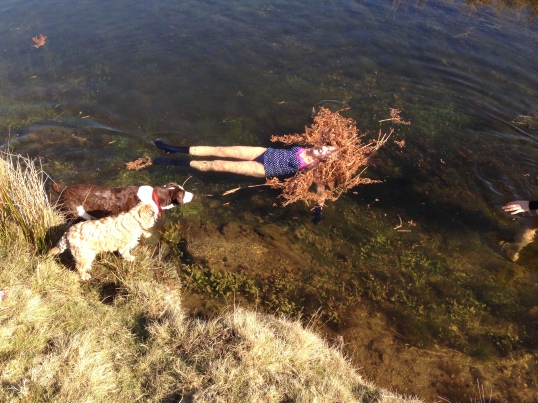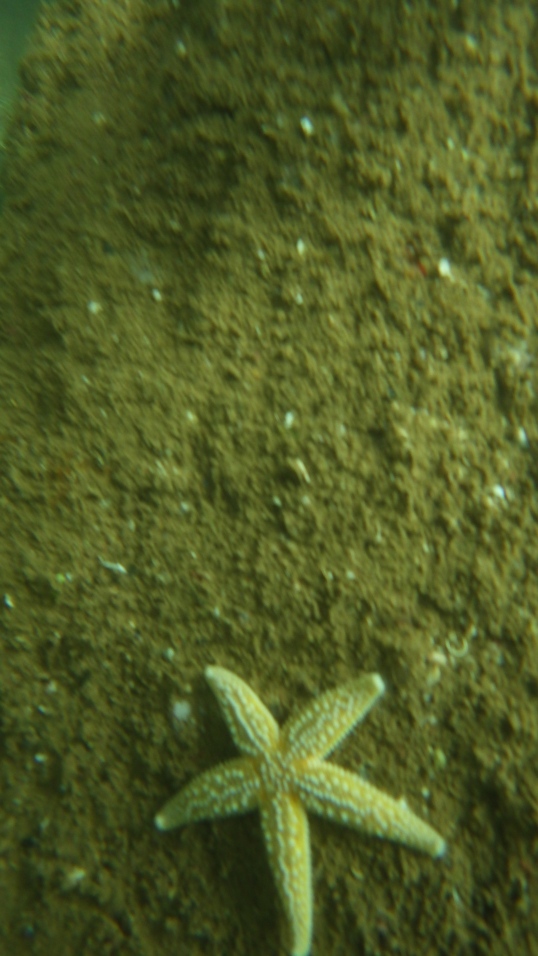
Spate in the Tavy – at one of WWW’s favourite dipping spots (though only a fool would enter the river on this day!)
A few months ago I stepped in as acting Outdoor Swimming Society Press Officer, and was immediately embroiled in a controversy involving an attack on our Wild Swim Map by a river ‘safety’ group. This is the resultant OSS piece.
Every summer we see stories in the media prompted by water-related deaths that contain misinformation about swimming and risk. “Undercurrents” drag unfortunate people into “hidden whirlpools”. Open water is icy and defies the laws of physics by never warming up, even on hot summer’s days. (This is especially so in reservoirs, where swimmers – but not kayakers, sailors or windsurfers – also get sucked down by the big pipes by supernatural currents.)
The premise of these stories is often that swimming outdoors is lethal. Misinformation is recycled by journalists, lake wardens and safety ‘experts’, campaigns are launched to ban swimming in certain places and to fence off flooded quarries.
Each death is a tragedy, and I’d argue that every time nonsense goes out obscuring the real story about deaths, we miss the opportunity to prevent more. It is central to the OSS ethos that people be allowed to swim at their own risk, and that through the OSS community people share and develop knowledge that enables them to better assess the risks they face. I know I am not alone among experienced outdoor swimmers in finding the storm surge of nonsense infuriating. So when I was asked to cover as OSS Press Officer I sensed an opportunity to counter these media-conjured bogeymen.
I did not have to wait long. In April a campaign group called Riverside Awareness UK (RUAK) launched an attack on the OSS Wild Swim Map. Their comments can be seen at http://wildswim.com/river-wharfe-at-collingham, and include the dangers of our old pals “undercurrents” and “hidden whirlpools” and “a horse and carriage” vanishing in the river at this beauty spot. “No river is ever safe!!!” was one of the assertions.
The story was picked up by a couple of local newspapers in Wetherby and Harrogate and a scare-mongering, anti-swimming story appeared accusing the OSS of being “totally irresponsible” for “encouraging” people to swim in a river where people have drowned in the past, and for not doing a risk assessment of spots on the map (a basic appreciation of the fact that rivers are fluid and change in their size, strength and risks from day to day appeared to escape both RUAK and the reporter).
OSS members launched a counter-attack on the Harrogate Advertiser’s website, using facts and figures about drowning risks and pointing out the rafts of badly-informed assumptions in the article, and the implied correlation between water related deaths and swimming deaths. For example, in 2012 ninety-nine water related deaths occurred in rivers. Just four of those were swimmers: twelve people were walking or running; four were angling. Others were engaged in a range of water sports or were simply found in the water (figures from National Water Safety Fatal Incident Reports, on which ROSPA base their information). It’s a fallacy to connect all river deaths to swimmers, just as it is to connect water-related deaths to open water. Looking more broadly at that year, there were 371water-related deaths attributed to accidental or natural causes in the UK. Of those, 26 were swimmers, but 10 died in domestic baths.
The Harrogate Advertiser piece was removed owing to some negative comments about the capabilities of the reporter. We did, however, agree with RAUK that the Wild Swim Map should contain a link to the OSS website Safety Advice, and are addressing that.
Then the Wetherby News contacted me for comment after a Police frogman told them a very sad story from the 1960s about two children drowning in the river Wharfe. He advised never swimming there. Again, I countered this with facts and figures and Dan Graham, a swift-water rescue instructor and OSS member, had a look at the spot on Google Earth. There was nothing in the topography to suggest the river is especially dangerous under normal conditions save some deep water and a couple of weirs. However, this is a flashy river (meaning it rises fast after rain), and it’s a beauty spot where people go to picnic. If you can’t swim, or you’ve been drinking, or you’re unused to the cold, or you don’t predict the increase in the speed of water after rain – that water that might have been friendly on your last visit is ferocious now – then of course this can be a dangerous place.
I gave the Wetherby News some safety pointers, which they printed – after a fashion.
Things have been calmer since then. Last week a paper in York contacted the OSS to comment on a river safety campaign in York, following a series of deaths in the town centre. We had the opportunity to provide safety points to them that helped shape the campaign – resulting, we hope, in information getting to more people that may help keep them safe. (These points are listed at the bottom of the article).
Following that BBC Newcastle radio contacted us to talk about a call from one of their local MPs, Sharon Hodgson from Tyne & Wear, for the government to do more to teach safe swimming in schools, and Kate Rew went on air to discuss swimming risks. (Speaking in a debate Mrs Hodgson has called for things such as every child to be taught the basic principles of water safety education and fundamental personal survival skills; an annual public awareness campaign highlighting the drowning risk; and sufficient safe and affordable public swimming facilities.) It’s the first time the OSS has been asked to comment on something so positive in terms of reducing risk.
People are drawn to water, they will usually ignore advice to stay away from it. Scare mongering is ineffective as a way of keeping people safe, and banning swimming because someone, tragically, loses their life is like banning driving because someone has an accident. ‘Danger: No Swimming’ signs have become meaningless to us now; installed so often in popular swimming places where the landowner would like to ban swimming, but has no right, that they’ve lost any power they ever might have had in places where there really are dangers to swimmers, such as weirs. To me ‘Danger: Deep Water’ has always been ludicrous as a warning – deep water is just what swimmers are looking for, the danger is only if you’re a weak or non-swimmer.
To me, risk and whether it’s acceptable to take it, is a decision that will always lie with the individual. It’s an impossibility to cover each specific eventuality of weather, rainfall, tides in the sea, currents, changes to topography after spates, and individual capability and experience.
This is the piece that appeared in The Press (the York newspaper who are running a river safety campaign in the city). Several OSS members have added comments below the article. I’d be interested to hear your views…
http://www.yorkpress.co.uk/news/11316989.Open_water_swimming_group_s_safety_warning_for_the_River_Ouse/






























